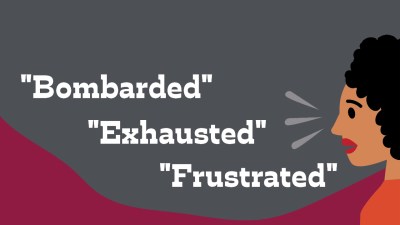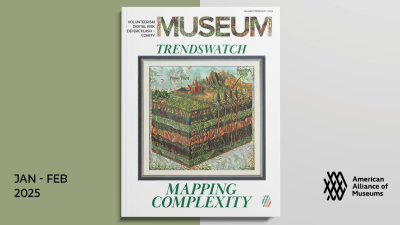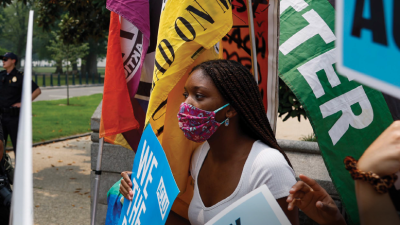
Introduction to This Scenario
“Fragmentation” weaves together some of the anxieties shared by museum people when we asked, “What are your fears about the future?” While we hope that these depressing themes don’t all play out at once, each event falls somewhere in the range of plausibility. (See Signals, below, for current trends and events that support that case.)
Why indulge in pessimistic thinking? Thinking about worst-case outcomes can actually be empowering. Many potential disasters seem like they would herald the end of the world. Upon reflection, however, we can create heroic narratives of how we could survive such cataclysms. Moreover, dark futures make for compelling storytelling. Name all the utopian novels and films you can think of. Now do the same for dystopic fiction. Which list is longer? Dark possibilities can energize planning by capturing participants’ imagination. Discussing this scenario can help museum leadership and key stakeholders:
- Identify critical risks and create early warning systems to monitor whether the probability and impact of these threats are increasing or decreasing. This exercise can counteract our natural tendency to focus the majority of our attention on typical everyday occurrences, averting our gaze from future possibilities.
- Recognize your organization’s vulnerabilities. Are your financial reserves too small to weather short-term setbacks in attendance or other income streams? Have you based your digital strategy on platforms or services that may change, disappear, or require significant investments to remain current? Is the average age of your members and donors 65 and climbing?
- Anxieties that float at the edge of your attention can eat an enormous amount of cognitive energy. Confronting your fears can help you place these rational concerns to one side, confident that you have strategies and tactics ready to deploy should they be needed.
- Once you reach consensus about plot elements that are both plausible and highly undesirable, this scenario will challenge your planning team to explore, “How can we make sure this does not come true?” The resulting filter will help ensure you do not use your organizational resources in ways that inadvertently make things worse. Dystopic thinking can also help you recognize and take advantage of opportunities to block, slow, or divert trends and events that may lead the world in a dark direction.
A Snapshot of This Future
This synopsis provides a high-level description of the year 2040 with respect to culture, technology, the economy, ecology, and policy.
American society has fragmented. People have aggregated into tight-knit physical and digital communities sharing similar backgrounds, life experiences, and political opinions. Income inequality and gentrification have combined to create highly homogeneous neighborhoods. “Digital redlining” by companies that filter content and restrict access based on personal data has created an equally segregated online world. Backlash against civil rights activism in the early century led to the rise of nationalism and the proliferation of hate groups, and political discord has driven parties to irreconcilable extremes. Trust in the government, nonprofit organizations, researchers, and advocacy groups are at an all-time low. The widespread use of technology that convincingly falsifies content, including audio and video recordings, has dealt a death blow to traditional journalism. Only three major cities—New York, Chicago, and Los Angeles—still support major newspapers. Locally, the news gap has been filled by crowdfunded publications and personal blogs.
The US population is both shrinking and aging. At the turn of the century, US population growth was driven by immigration and by a high birth rate among recent immigrants. Two and a half decades of tight immigration policies have reversed this trend, and the national fertility rate is now only 1.6—far below the 2.1 rate needed to maintain a stable population. This decline has also skewed the age ratio: one-quarter of the population is over the age of 65 and only one in five is under the age of 18. While economic necessity drives many people to work long past the traditional age of retirement, there is still an enormous financial burden on the young to support those no longer able to work. There is also an acute shortage of people able and willing to provide home and health services for the elderly.
Wealth inequality has reached a tipping point. The nation has trifurcated into three well-defined cadres: the .1 percent, the 9.9 percent, and everybody else. Life status in the US is almost entirely determined by parentage, with very little mobility among social and economic classes. The government-funded social safety net that shaped the last half of the 20th century has been largely dismantled, replaced, in part, by private charity and a patchwork of nonprofit efforts. The small percentage of the population that makes charitable contributions is drawn, for the most part, from the elite .1 percent. These “mega-philanthropists” wield enormous influence not only in traditional areas of philanthropy—culture and human services—but also in education, health, and public infrastructure. The Occupy Wall Street movement, formed in response to the economic collapse of 2008, has grown into a large, decentralized underground movement working for social and economic reform.
Technology has driven massive disruptions in labor. Despite assurances that it would “supplement, not supplant” human workers, artificial intelligence (AI) has destroyed jobs in white-collar strongholds such as law and medicine as well as blue-collar bastions like telemarketing and long-haul trucking. Much of the displaced workforce has not found stable employment, and instead continually pieces together temporary assignments to support their basic needs. This tenuous “gig” lifestyle offers neither retirement benefits nor health insurance.
Privacy is a luxury good. Much of the new tech wealth was created from the collection and exploitation of personal data, giving rise to a thriving subculture of individuals dedicated to digital anonymity, ranging from individuals who go entirely offline and evade ubiquitous public surveillance, to “digital ghosts” who fake or mask their online identities. The so-called “Dark Web,” once primarily known as a platform for illegal activity and terrorism, is a haven for the privacy underground, and much political and social activism is organized via highly encrypted Darknet sites that enable users to talk, blog, and share files confidentially. One important subgroup of the underground is comprised of people of color committed to evading the bias embedded in the AI algorithms that control so much of our lives, including educational assessment, job placement, public recognition, and awards.
Critics contend that education in 2040 is neither universal nor public. Many school districts depend on a small and shrinking tax base, and for-profit charter companies have siphoned off a large portion of the monies that remain. Public schools typically have a 1:100 teacher to student ratio and the principal role of educators is to supervise the massive classrooms where students sit at terminals, accessing instructional software. Affluent families typically send their children to private schools or hire tutors. Elite colleges and universities have thrived, buoyed by their endowments and by students able to pay hefty tuitions. While these wealthy institutions do provide full scholarships for many students, these subsidized spots barely make a dent in the national need for affordable higher education. A large number of second- and third-tier colleges and professional schools have closed in the face of declining enrollment, done in by two decades of rising student debt, scandals related to for-profit diploma mills, and the gradual decoupling of degrees from salaries that enable graduates to repay student debt.
The world is on track to meet the worst-case projections of climate change. Drought, high temperatures, and weather instability have damaged agriculture in many regions, resulting in rising prices and food insecurity. Farmers in the central valley of California no longer grow fruit and nuts, as the trees no longer receive sufficient “chill hours” to bloom and set fruit. Much of Florida can no longer be used for agriculture due to rising salt water tables. Climate change has accelerated urbanization, and 90 percent of Americans now live in high-density megalopolises in order to access affordable climate control and minimize commuting. Demand for urban land has led to the loss of over half the green space that graced cities at the turn of the century. However, the large tracts of abandoned suburban and rural property created by human migration are an unexpected boon for species looking for a foothold in a changing world.
Signals
A selection of real news stories and research from the present illustrating trends and events that could create this version of the future.
On the fragmentation of physical and digital communities
The Pew Research Center has documented the rise of residential segregation by income since 1980, and in The Big Sort (2008), journalist Bill Bishop and sociologist Robert Cushing explored how choosing communities based on shared lifestyles results in political self-segregation. (How strong is the correlation between lifestyle and political affiliation? In 2017 a team of researchers from Stanford created a “surprisingly accurate” AI tool to predict how residents of a given neighborhood vote, based on Google Streetview images of their cars.) Microsoft researcher danah boyd has written extensively about how social platforms originally intended to create digital connections have left us feeling isolated and depressed. In a 2017 essay, boyd also explored how two major structures supporting diversity in the US—the military and college life—are being undermined by privatization and by digital tools, respectively.
On the future of trust
Since it launched in 2000, the Edelman Trust Barometer has tracked trust in business, media, government, and NGOs across the globe. The year 2017 marked the first time that the Barometer documented a decline in trust in all four of these sectors, and 2018 documented the largest-ever-recorded drop in the survey’s history among the general population of the US. The rise of sophisticated technology capable of faking digital audio and video content may well make the situation worse. In 2018, an international team of researchers announced the development of Deep Video Portraits, an AI application that creates highly convincing fake videos by using recordings of actors to alter source footage of real people. While the researchers focus on legitimate practical applications (e.g., improving dubbing or editing during movie production), they concede that unethical users could use the software to create phony footage of politicians or other public figures.
On wealth inequality and the future of philanthropy
In June 2018, the Chronicle of Philanthropy noted that the percentage of American households giving to charity is declining, while those who do donate are giving more (a pattern that holds true among both younger and older donors). In this philanthropic climate, individual donors wield outsized influence in the areas they choose to fund. For example, the mega-philanthropy of billionaires such as Steven and Connie Ballmer, Denny Sanford, Priscilla Chan and Mark Zuckerberg, and Bill and Melinda Gates is shaping the direction of P-12 education reform. Philanthropists are stepping up to fund other kinds of public infrastructure as well. In 2017, city managers in Kalamazoo, Michigan, accepted major contributions from two wealthy individuals to pay for a quarter of the city’s operating budget for three years. These donors also provided seed money for a charitable foundation designed to fund city government and reduce the tax burden over the long term. While some residents saw financing tax reduction as an equitable way to distribute benefits, critics warned that it may give individual philanthropists outsized influence over what services cities chose to fund.
On the unraveling of public and higher education
In 2017, the nonprofit advocacy organization Network for Public Education released Charters and Consequences, summarizing their ongoing investigation of the charter school industry. The report concludes that charter schools overall exacerbate segregation by race, socioeconomic status, language, and (dis)ability, and divert money from the public school systems. Futurist Bryan Alexander has been tracking the onset of “peak higher education” since 2013. In his work, Alexander documents how lower birth rates, declining enrollment, the rising exploitation of adjunct faculty, soaring student debt, and other factors lead to shrinking campuses, program elimination, mergers, and closures.
Discussion Guide
Reality Check
Despite the signals listed above, you may feel that some of the elements in this story are implausible. If so, see if you can find recent stories or research that bolster your case for pushing these plot lines towards the edge of the “Cone of Plausibility.”
Agree/Disagree
You may hate some parts of the future envisioned in “Fragmentation,” or you may feel that certain elements of this scenario, as written, wouldn’t be so bad. That’s great! Disagreement can spark discussion about values and surface differences of opinion. Use this story as a starting point and edit, adapt, and develop it to reflect your organization’s shared version of a dark future.
Museums in This Future
What are some implications of this future for museums? To seed your thinking, here are a few statements about what might be true about museums in a fragmented world:
- In a society shaped by extreme wealth inequality, most museums fall into one of three categories: a growing number of “private” museums funded by affluent founders who retain a large measure of control over operations and content; profitable nonprofits that primarily serve the 10 percent of the population who can afford high admission fees; and small, mostly volunteer community museums that self-organize around local needs.
- In an effort to foster trust in their content, many museums commit to providing “open evidence”—comprehensive, publicly available documentation of the sources undergirding the museum’s exhibits and published materials. Museums have found that one particularly effective practice is to invite members of the skeptical public to examine original archives and artifacts, as, in an era of sophisticated digital fakery, analog evidence commands more trust.
- Museums that serve low-income neighborhoods often operate P-12 education cooperatives that offer a high-quality, affordable alternative to overcrowded public schools. Respect and appreciation for the work of these museum schools are major drivers of deep grassroots support for community museums.
From Insight to Foresight
Exploring dystopic scenarios helps us futureproof plans by asking, “In the face of challenges posed by this future, how would I/my family/my community/my museum thrive?” By answering this question across several scenarios, you may identify actions that would be beneficial in a variety of circumstances.
In this future I might:
In this future my organization might:
From Foresight to Action
This story is built around trends and events we can see in the world today. But always remember the third force creating the future: the choices that we make as individuals and as organizations. The most important part of this exercise is discovering how you can help build the future you want to live. After you’ve tweaked this scenario to reflect a future you agree is both plausible and preferable, work on the following questions:
To help prevent this future I might:
To help prevent this future my organization might:









While this not entirely unlikely (and all too plausible) vision of the future doesn’t expressly say so, it’s pretty much a look at what would happen if conservative policy is taken to full conclusion. This is not to say that none of these things could happen under more liberal political leadership, (the influence of money doesn’t discriminate) but many of the mechanisms leading to these envisioned outcomes (deconstruction of the social safety net, privatization of public education and infrastructure, lower taxes, etc.) are core tenets of modern conservatism.
Let me thank Elizabeth Merritt and her staff for challenging us to plan for a dystopian future, and for inviting suggestions for the final Trends Watch report. May I suggest that museum planners would find this scenario more useful if it showed more precisely how broad social trends might impact museums? In social science terms, treat museums more rigorously as the dependent variable — and take more than three of about 25 paragraphs to explore those effects. For example:
On what we might call the demand side — what users of museum services might want — an aging population might suggest that museums should spend more resources on the elderly — arranging more partnerships with assisted living communities, starting programs for those with dementia; perhaps offering fewer programs for young families.
On what we might call the supply side, such as tax revenues and philanthropic gifts, division of the country into enclaves might have different effects in “progressive” areas (the 487 counties that Clinton won in 2016, which generated 64% of the US GDP? https://www.brookings.edu/blog/the-avenue/2016/11/29/another-clinton-trump-divide-high-output-america-vs-low-output-america/ ) than in “conservative” ones (the 2,626 counties that Trump won in 2016, which generated 36% of the GDP?). Wealthy “progressive” areas might be able to support richer museums, and perhaps exhibits and programs that supported social justice and “the resistance.” Or, such enclaves of “underground activists” might devote more funds to the homeless with less for museums. Conservative enclaves might prefer low taxes and view museums, especially university museums and science centers, with suspicion. And in both areas, if tax support and private giving will be low in 2040, shouldn’t museums now be squirreling away reserves — spending less on new buildings and blockbuster exhibitions, and placing more money into endowments?
Technical note #1: For reasons not explained, the Bright Future scenario uses US Census projections, based on the 2000 census, for 2030 and 2050 not 2040: https://www.census.gov/prod/2010pubs/p25-1138.pdf . Census projections specifically for 2040, based 2010 census, seem more appropriate and accurate: https://www.census.gov/content/dam/Census/library/publications/2015/demo/p25-1143.pdf ).
Technical note #2: The Fragmentation scenario claims for 2040 that “The US population is both shrinking and aging.” In common usage, “shrink” means to become smaller. The US Census projects population in 2040 at 380 million, up from about 327 million now; a lesser rate of increase does not mean an absolute reduction in population. See the Census projection cited in Note 1 and https://www.populationpyramid.net/united-states-of-america/2040/